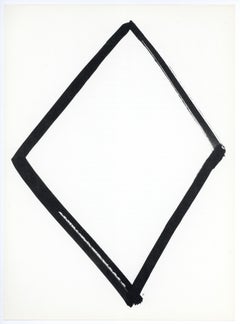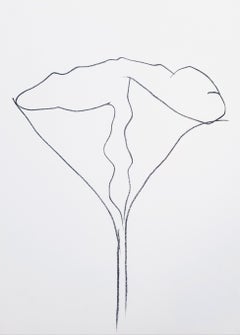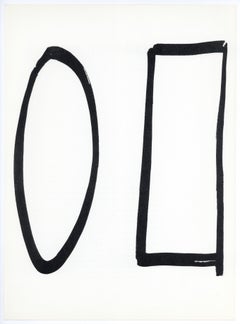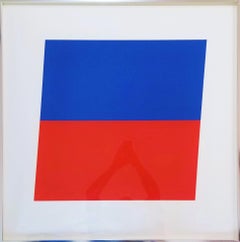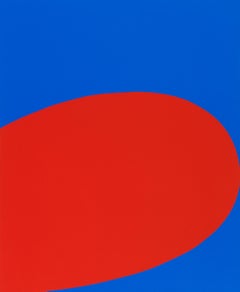Ellsworth Kelly
Ellsworth Kelly was one of the key figures in postwar American art, exercising major influence on the fields of Pop art, minimalism, Color-Field and hard-edge painting. Widely known for his brightly colored geometric compositions, he was among the first artists, alongside his contemporary Frank Stella, to use irregularly shaped canvases. Although highly abstract, Kelly’s paintings and prints are precise expressions in color and form of his sensory experience of the world.
Kelly's works, both two- and three-dimensional, are in the collections of the Museum of Modern Art, the Metropolitan Museum of Art, the Los Angeles County Museum of Art, and displayed at such sites as the UNESCO headquarters in Paris.
Kelly grew up in the town of Newburgh, New York, near the Oradell Reservoir. He was an avid birder as a child and loved the colorful illustrations of naturalist John James Audubon. Encouraged to study art by a high school teacher, he enrolled at the Pratt Institute in Brooklyn, remaining there until 1943, when he was inducted into the army. During World War II, he served along with scores of other artists, in a unit known as the Ghost Army, where he learned the elements of camouflage while creating ersatz trucks and tanks intended to mislead Axis forces.
When the war was over, Kelly took advantage of the G.I. Bill to study painting at the School of the Museum of Fine Arts, Boston, drawing inspiration from the museum's collections, and, later, at the École nationale supérieure des Beaux-Arts, in Paris. While in France, he immersed himself in the varied artistic movements and styles represented there and befriended Americans avant-gardists, such as composer John Cage and choreographer Merce Cunningham, as well as the German-French Surrealist Jean Arp and Romanian sculptor Constantin Brâncuși.
Upon his return to the United States, in 1954, he found himself at odds with the dominant style of the period, Abstract Expressionism, which favored a dynamic and energetic application of paint in a loose manner. Like Stella, Kelly was interested in formal precision and explorations of color. Following an exhibition of his work at the Betty Parsons Gallery in 1956, Kelly’s work was included in the "Young America 1957” show at the Whitney Museum of American Art.
During the 1960s, Kelly played with color and form to tease out and celebrate the tension between a painting’s subject and its background. In one of his most famous works, 1963's Red Blue Green, for example, two shapes, one red, one blue, both contrast and resonate with a green background that extends to the edge of the canvas on both sides, appearing at moments to be the work’s primary shape. To explore this relationship between form and ground further, Kelly began using nontraditional, shaped canvases, as in the monochromatic 1966 Yellow Piece, from, whose two curved corners draws the eye to the wall behind it, as though the gallery wall itself were part of the composition. A lithograph from the same period, Blue and Orange consists of two shapes in the title’s complementary colors facing off against one another with a tension that makes them appear almost animated.
Kelly made drawings and prints throughout his career, using plants and flowers as his primary source of inspiration. Like his paintings, his drawings tend to be relatively flat in perspective, but they are rarely abstract. A 1993 drawing of an oak leaf is clearly representational, but rendered with very minimal color and line. In the mid-1960s, he produced the series “Suite of Twenty-Seven Lithographs” with the Paris-based Maeght Éditeur.
Later, collaborating with Gemini G.E.L., he created very large-scale works, such as 1988’s Purple/Red/Gray/Orange, which is 18 feet long and might be one of the biggest lithographs ever made. Kelly produced 140 sculptures, including the aluminum White Curves, created for the Fondation Beyeler, in Riehen, Switzerland, in 2002. In his three-dimensional works, as in his paintings, Kelly used form, color and light to play with perceptions of surface and depth, inviting viewers to look closely and see the world in a new way.
Find original Ellsworth Kelly art on 1stDibs.
| Average Sold Price |
| $1,447 |
| Styles |
| Materials |
| Related Artists |
1980s Minimalist Ellsworth Kelly
Pencil, Graphite, Board
Ellsworth Kelly2 Unique Museum Works: Drawing of Cyclamen III, and collage for Conques, Signed, 1987
1960s Ellsworth Kelly
Lithograph
1980s Minimalist Ellsworth Kelly
Lithograph
Early 2000s Minimalist Ellsworth Kelly
Lithograph
1950s Ellsworth Kelly
Lithograph
1960s Ellsworth Kelly
Lithograph
1970s Minimalist Ellsworth Kelly
Lithograph, Plexiglass
1960s Minimalist Ellsworth Kelly
Screen
Ellsworth Kelly Sale Prices
| Sold Date | Sold Price | Category | Medium | Creation Year | |||||||||||||||||||||||||||||||||||||||||||||||||||||||||||||||||||||||||||||||||||||||||||
|
| $1,447 |
Average sold price of items in the past 12 months |
| $200-$10,000 |
| Sold price range of items in the past 12 months |
Ellsworth Kelly art for sale on 1stDibs.
- Why is Ellsworth Kelly famous?1 Answer1stDibs ExpertOctober 30, 2024Ellsworth Kelly is famous for his work as an artist. He was one of the key figures in postwar American art, exercising a major influence on Pop art, Minimalism, color field painting and hard-edge painting. Widely known for his brightly colored geometric compositions, he was among the first artists, alongside his contemporary Frank Stella, to use irregularly shaped canvases. Although highly abstract, Kelly’s paintings and prints are precise expressions in color and form of his sensory experience of the world. Some of his most famous pieces include Red Blue Green, Colors for a Large Wall, Green Curve and Cité. On 1stDibs, shop an assortment of Ellsworth Kelly art.
- Where did Ellsworth Kelly work?1 Answer1stDibs ExpertSeptember 16, 2024Ellsworth Kelly worked in Spencertown, New York. He was one of the key figures in postwar American art, exercising a major influence on the fields of Pop art, minimalism, Color Field and hard-edge painting. Widely known for his brightly colored geometric compositions, he was among the first artists to use irregularly shaped canvases. Although highly abstract, Kelly’s paintings and prints are precise expressions in color and form of his sensory experience of the world. On 1stDibs, shop a selection of Ellsworth Kelly art.
- 1stDibs ExpertAugust 15, 2024Here are some interesting facts about Ellsworth Kelly. As a child growing up in Newburgh, New York, near the Oradell Reservoir, he was an avid birder and loved the colorful illustrations of naturalist John James Audubon. A high school teacher encouraged him to study art, so he enrolled at Pratt Institute in Brooklyn, studying there until 1943, when he enlisted in the army. During World War II, he served, along with scores of other artists, in a unit known as the Ghost Army, where he learned the elements of camouflage while creating fake trucks and tanks intended to mislead Axis forces.
When the war was over, Kelly took advantage of the G.I. Bill to study painting at the School of the Museum of Fine Arts in Boston, drawing inspiration from the museum's collections. He later studied at the École nationale supérieure des Beaux-Arts in Paris.
Kelly went on to become one of the key figures in postwar American art, particularly influencing Pop art, minimalism, color field and hard edge painting. Widely known for his brightly colored geometric compositions, he was among the first artists, alongside his contemporary Frank Stella, to use irregularly shaped canvases. Although highly abstract, Kelly’s paintings and prints are precise expressions in color and form of his sensory experience of the world. Explore a collection of Ellsworth Kelly art on 1stDibs. - 1stDibs ExpertNovember 4, 2024Ellsworth Kelly used a variety of materials over the course of his career. The American artist produced paintings with oil paints on canvas and two-dimensional works with a sponge roller and oil-based ink. Kelly was also a sculptor, experimenting with steel, aluminum and bronze as well as birch, elm, mahogany, maple and oak woods. On 1stDibs, shop a selection of Ellsworth Kelly art.
- 1stDibs ExpertMarch 22, 2022Ellsworth Kelly is known for being an influential American artist. His work helped popularize hard-edge painting, the practice of creating sharp, bold transitions between colors. Some of his most famous paintings include Colors for a Large Wall, Four Panels, Red Blue Green and Yellow Piece. On 1stDibs, find a selection of Ellsworth Kelly art.
- 1stDibs ExpertApril 5, 2022Ellsworth Kelly made many kinds of art. He produced paintings, sculptures and prints, working primarily in the styles of Minimalism and Color Field painting. Some of his most famous works include Colors for a Large Wall, Red Blue Green, Four Panels and Yellow Piece. Find a collection of Ellsworth Kelly art on 1stDibs.
- 1stDibs ExpertNovember 4, 2024The meaning of Yellow Piece by Ellsworth Kelly is open to interpretation, as the artist never explained its significance. Although highly abstract, Kelly’s paintings and prints are precise expressions in color and form of his sensory experience of the world. Yellow Piece marks the first time the American painter used shaped canvas for his work. It is a fine example of Minimalism, an art movement focused on reducing art to its most basic shapes. In Yellow Piece, the color yellow, evocative of warmth, appears on its own. On 1stDibs, find a diverse assortment of Ellsworth Kelly art.

